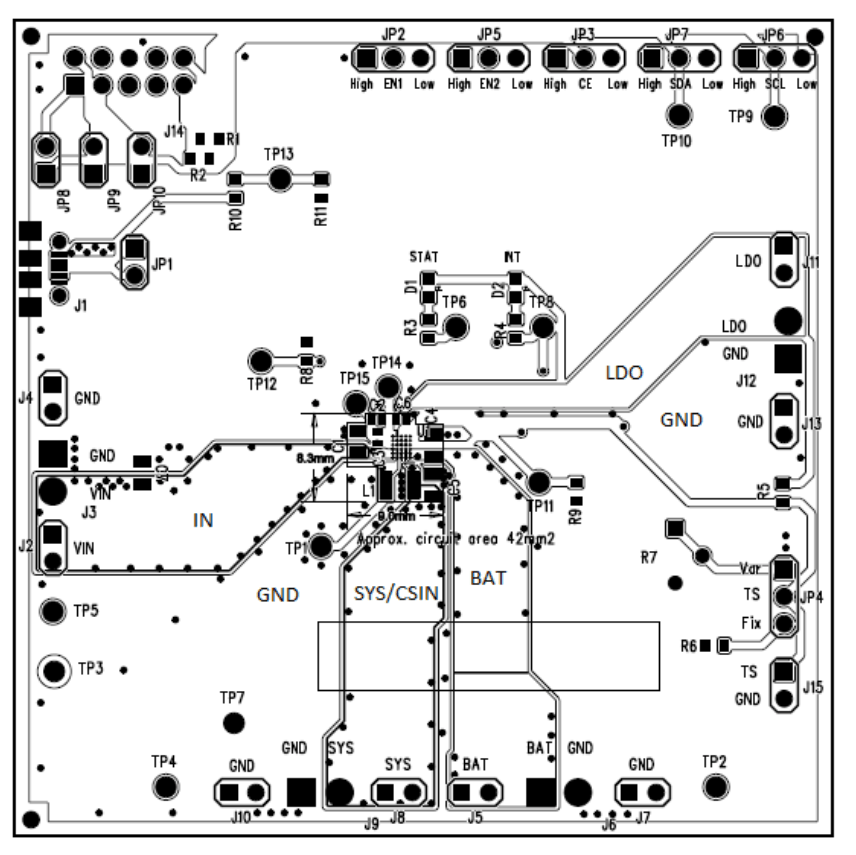ZHCSAF6H October 2012 – August 2015 BQ24250 , BQ24251 , BQ24253
PRODUCTION DATA.
- 1 特性
- 2 应用
- 3 说明
- 4 修订历史记录
- 5 说明 (续)
- 6 Device Options
- 7 Pin Configuration and Functions
- 8 Specifications
-
9 Detailed Description
- 9.1 Overview
- 9.2 Functional Block Diagram
- 9.3
Feature Description
- 9.3.1 Charge Profile
- 9.3.2 EN1 and EN2 Pins
- 9.3.3 External Settings: ISET, ILIM and VIN_DPM
- 9.3.4 BC1.2 D+/D- Detection
- 9.3.5 Transient Response
- 9.3.6 AnyBoot Battery Detection
- 9.3.7 Input Voltage Based DPM
- 9.3.8 Sleep Mode
- 9.3.9 Input Over-Voltage Protection
- 9.3.10 NTC Monitor
- 9.3.11 Production Test Mode
- 9.3.12 Safety Timer
- 9.3.13 Watchdog Timer
- 9.3.14 Fault Modes
- 9.3.15 Dynamic Power Path Management
- 9.4 Device Functional Modes
- 9.5 Programming
- 9.6 Register Maps
- 10Application and Implementation
- 11Power Supply Recommendations
- 12Layout
- 13器件和文档支持
- 14机械、封装和可订购信息
12 Layout
12.1 Layout Guidelines
- Place the BOOT, PMID, IN, BAT, and LDO capacitors as close as possible to the IC for optimal performance.
- Connect the inductor as close as possible to the SW pin, and the SYS/CSIN cap as close as possible to the inductor minimizing noise in the path.
- Place a 1-μF PMID capacitor as close as possible to the PMID and PGND pins, making the high frequency current loop area as small as possible.
- The local bypass capacitor from SYS/CSIN to GND must be connected between the SYS/CSIN pin and PGND of the IC. This minimizes the current path loop area from the SW pin through the LC filter and back to the PGND pin.
- Place all decoupling capacitors close to their respective IC pins and as close as possible to PGND (do not place components such that routing interrupts power-stage currents). All small control signals must be routed away from the high-current paths.
- To reduce noise coupling, use a ground plane if possible, to isolate the noisy traces from spreading its noise all over the board. Put vias inside the PGND pads for the IC.
- The high-current charge paths into IN, Micro-USB, BAT, SYS/CSIN, and from the SW pins must be sized appropriately for the maximum charge current to avoid voltage drops in these traces.
- For high-current applications, the balls for the power paths must be connected to as much copper in the board as possible. This allows better thermal performance because the board conducts heat away from the IC.
12.2 Layout Example
 Figure 34. Recommended bq2425x PCB Layout for DSBGA Package
Figure 34. Recommended bq2425x PCB Layout for DSBGA Package
12.3 Thermal Considerations
During the charging process, to prevent overheat of the chip, bq2425x monitors the junction temperature, TJ, of the die and begins to taper down the charge current once TJ reaches the thermal regulation threshold, TREG. The charge current is reduced when the junction temperature increases above TREG. Once the charge current is reduced, the system current is reduced while the battery supplements the load to supply the system. This may cause a thermal shutdown of the IC if the die temperature rises too. At any state, if TJ exceeds TSHTDWN, bq2425x suspends charging and disables the buck converter. During thermal shutdown mode, PWM is turned off, all safety timers are suspended, and a single 256μs pulse is sent on the STAT and INT outputs and the FAULT/STAT bits of the status registers are updated in the I2C. A new charging cycle begins when TJ falls below TSHTDWN by approximately 10°C.